Letters from Lodi
An insightful and objective look at viticulture and winemaking from the Lodi
Appellation and the growers and vintners behind these crafts. Told from the
perspective of multi-award winning wine journalist, Randy Caparoso.
Lorenza's dry rosés defy age and exemplify the intricate minerality possible in Lodi-grown fruit
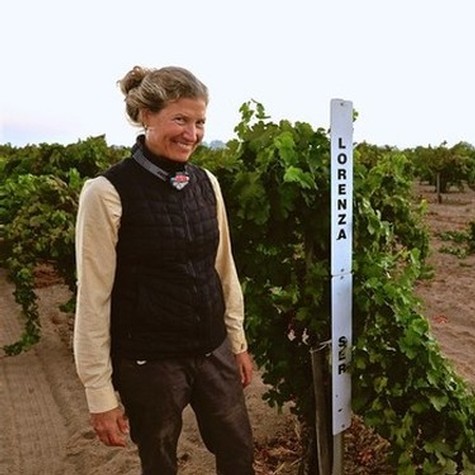
Lorenza True Rosé's Melinda Kearney with signpost marking her block in Bechthold Vineyard, Lodi's oldest vineyard (own-rooted Cinsaut planted in 1886).
A mother/daughter team finds rosé heaven in Lodi
One of the hottest wine categories over the past few years has been dry rosé. Everybody's drinking dry rosés. It's great for casual wine lovers, but the sensory complexity of bottlings out in the market has grown so varied, even connoisseurs have taken to sipping rosés in between their high-class Bordeaux and Burgundies.
Lorenza True Rosé is a brand that has been dedicated 100% to dry rosé since 2008. It is their specialty, their obsession — the "their" being a mother/daughter team named Melinda Kearney and Michèle Ouellet Benson — and all 15 vintages of their wines so far have been sourced almost entirely from Lodi.
15 vintages, as it were, have also been enough for Kearney and Benson to discover one salient, somewhat wholly unsuspected, fact: That authentic, well-balanced dry rosés are fantastic when aged in the bottle. The prevailing opinion in the wine world, that rosés always need to be consumed as young as possible to enjoy their teeming fruit qualities when still tender, only holds true when the structure and depth of the fruit qualities are insufficient to warrant bottle aging. For most rosés, this is true.
The wines of Lorenza True Rosé, however, are crafted "intentionally" — a word Kearney likes to use — to go the opposite way of most commercial dry rosés. Grapes are picked at very low sugars to preserve high natural acidity and convert into lower alcohol levels (usually around 11%), and vineyards are sourced for maximum intrinsic depth, complexity, and intricate layering of fruit expression.
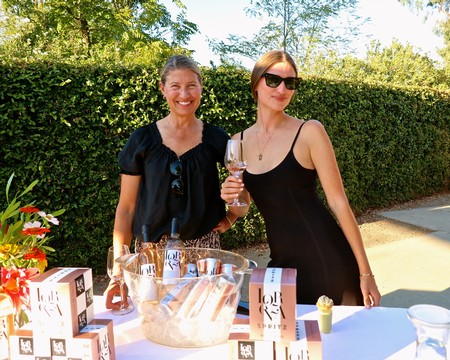
The Lorenza True Rosé mother/daughter team of Melinda Kearney and Michèle Ouellet Benson pouring at a women's winemakers event in Lodi.
For instance, one of the vineyards utilized by Kearney and Benson from the beginning is Lodi's Bechthold Vineyard, consisting of own-rooted, organically farmed Cinsaut vines originally planted in 1886. Serious stuff. Crafting rosé from a vineyard like Bechthold is like hiring Peyton Manning to play catch with your kid in the backyard. A little bit of an overkill, but guaranteed to be a teaching moment.
To demonstrate their discovery of how well their Lorenza rosés have been aging, Kearney opened up a vertical of five vintages going as far back as 2010. Every bottle was distinctive, fresh, and eminently appealing. You'll find our comments on the sensory qualities of each wine below.
After tasting each Lorenza rosé, the two of us repaired to Lodi's M Sushi Bistro so that Kearney could make another one of her points: How crisp, light, layered dry rosé matches effortlessly with contemporary style foods — especially the inventive, Asian style cuisine found in a restaurant like M Sushi. You'll also find our notes on our culinary findings below, at the end of this post (warning: it will make you hungry!).
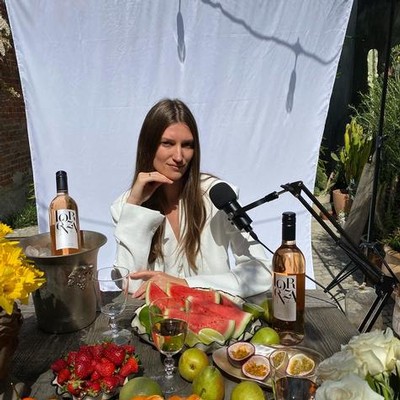
Lorenza True Rosé's Michèle Ouellet Benson. Photo courtesy of Michèle Ouellet Benson.
The Lorenza True Rosé story
But first, I let Ms. Kearney tell her own story, which is an interesting one. It's a story of a self-motivated woman who taught herself how to navigate a gigantic, intimidating, multi-layered industry on her own terms. It also lends credence to the belief now shared by a good number of handcraft vintners — that Lodi is the go-to place for cultivars of Mediterranean origin, which also happen to be the ideal grapes for rosés. Seek and you shall find.
In Kearney's own words...
I grew up in Boulder in a big family during the 1970s. In Colorado, I worked in the restaurant industry and loved to cook. I moved to Napa Valley in 1988 with my ex-husband, and was home with my first child, Michèle, up until 1990. It was at a chance meeting during a dinner at Mustards [a popular Napa Valley restaurant] where I met a vineyard owner who immediately offered me a job as a Director of Operations for a small winery with something of a "hippie" label. I literally learned the business by the seat of my pants, doing everything from inoculating Chardonnay and fermenting Pinot Noir to sales and marketing. I also discovered that I loved everything about the wine industry — the kinetic energy, and being able to build on things.
In 1992 I took on a bigger job, as Vice President of Sales and Marketing for Frog's Leap Winery, during a time when it was growing to 50,000 cases a year. I was part of that for 10 years. I especially loved building cool markets, in places like Europe and Japan, which helped double our sales. What was also cool was the Frog's Leap's style which was a lean, elegant style, more suitable for food and in that sense, very much a European sensibility — the opposite of "Parkerized," as such, considered very much contrarian in those days.
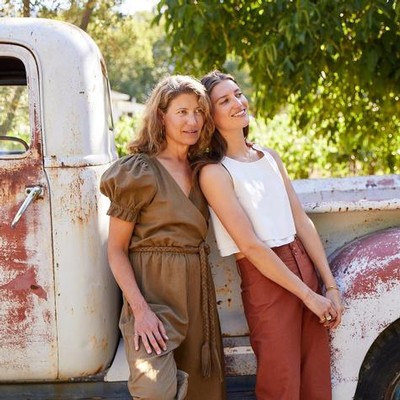
Lorenza True Rosé's Melinda Kearney and Michèle Ouellet Benson. Photo courtesy of Michèle Ouellet Benson.
In 2002, as my two kids were entering high school, I started my own consulting company (Melinda Kearney Wine Marketing) and worked with a number of top Napa Valley brands, such as Long Meadow Ranch, Altamura Vineyards, Wolf Family, BRAND Napa Valley, Evening Land, and others.
It was in 2008 when I got the inspiration to start Lorenza True Rosé. A big reason for it was to spend more time with my daughter, who was working as a model. When Michèle was first living in Europe, she came back and said, "Mom, I love rosé, that's what they drink there!" She was only 16 at the time, but it gave us the idea of starting a rosé-focused business, which was on the back burner for two years. The idea gave us the opportunity to do something of substance together, even as she continued to fly off to photoshoots around the world.
Having originally come out of the restaurant industry, I had "discovered" Domaine Tempier [the Bandol, Provence estate that reputedly makes the finest rosé in the world] long ago. We were also a "food" family; our kids were very tuned into cooking and wine. Our goal was to make something with Domaine Tempier serving as our ideal. We visited Tempier and studied that wine and the grapes that go into it [Mourvèdre, Grenache, and Cinsaut]. Lodi, as it turned out, was where we discovered we can get these grapes, growing in similar circumstances.
For our first vintage, 2008, we started off with 250 cases of Lorenza True Rosé. Since then the wine has been sourced entirely from Lodi, except in recent years when we began to supplement with Mourvèdre from Contra Costa County.
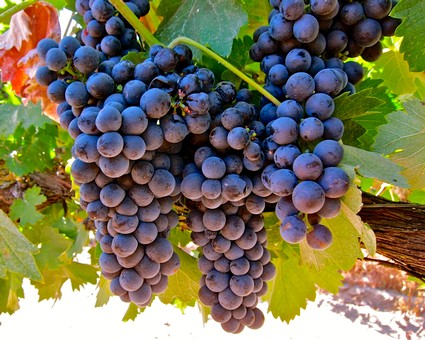
Ripken Vineyards Mourvèdre.
By our second vintage, we began to form very close working relationships with our Lodi growers. These vineyards are farmed by people, such as the Ripken family, who are committed to farming mindfully; if not organically like Bechthold Vineyard, at least according to LODI RULES for Sustainable Winegrowing. Some of the vineyards are extremely old, such as the Bechthold Cinsaut, or the Carignan from Spenker Ranch and Rauser Vineyard planted in the early 1900s. Old vines are inherently stable, producing a wine that successfully evolves with time. We have found the fruit from Lodi has great depth, even at the low-level ripeness that we like to pick at.
We asked, what if we made a disciplined rosé? That is, with grapes picked specifically for rosé, which means at very low sugars, preferably under 20° Brix [i.e., sugar reading]. The idea is to end up with something completely dry and lean, with a mineral character you often find in Bandol. You are more likely to get that with early-picked grapes. This, of course, was a style we preferred to drink, which we also thought was what a lot of people were looking for but not necessarily finding, at least in California.
In the beginning, we were forced to co-ferment our grapes because our production was so small. As we grew and increased our grape volumes, we could begin to pick the grapes at different times and ferment them in separate tanks, doing the blending afterward. This also enabled us to fine-tune our picking. For instance, while we might aim for 20° Brix, by the time a grower got to a field the grapes might be at 22° [less preferred because this produces a rosé that is higher in alcohol and lower in natural acidity].
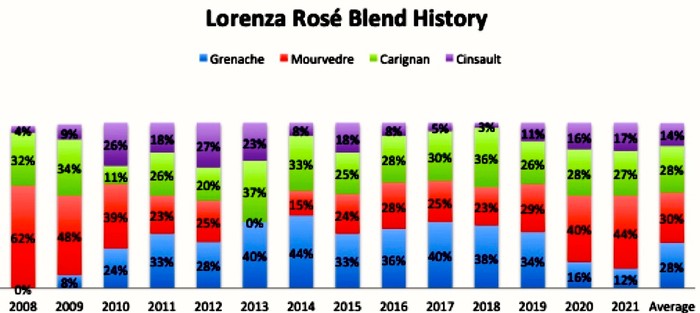
The grape blends of all 14 vintages of Lorenza True Rosé thus far.
By the same token, though, we might end up with grapes as low as 16° or 17° Brix because sugar readings are not always accurate, but the balance of all the lots blended will still give us the style of wine we want. The key is that I feel that we have gotten to know our vineyards and growers better and better each year; so much so, I think the best wine we have ever made may be our latest, 2021.
All of our vintages have remained more or less the same in terms of grapes used — Grenache, Mourvèdre, Carignan, and Cinsaut — with the percentages varying slightly each year, depending upon circumstances such as availability of grapes, or our production or market needs. We have produced as many as 7,000 cases [in 2018], but recently we've had to go back down a little [in 2021 4,000 cases of Lorenza True Rosé were produced]. 75% of our production is sold through distributors in 15 states, and out of that, about 60% have been restaurant placements, not the best deal during the pandemic. Our biggest markets outside of California have been New York, South Carolina, Texas, Colorado, and Utah, and we're right about to expand to Florida.
Four years ago we conducted a vertical tasting [i.e., a tasting comparing multiple vintages] with sommeliers in New York on the occasion of our 10th anniversary. I was extremely nervous about it, but the taste brought tears to my eyes. The older wines in particular blew people away. Their freshness and balance were totally unexpected. Maybe not so much to us, but certainly to these sommeliers. The tasting truly demonstrated what aged rosés have to offer, which is not something anyone really thinks of.
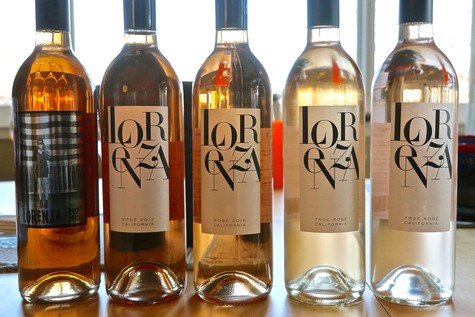
Five vintages (2010, 2012, 2016, 2019 and 2021) of Lorenza True Rosé.
Vertical of Lorenza True Rosé
2010 Lorenza True Rosé (39% Mourvèdre, 26% Cinsaut, 24% Grenache, 11% Carignan)
The color is still pretty pink. While the nose has undertones of caramelization indicative of oxidation (inevitable in older wines subjected to the slow effects of exposure to oxygen originally trapped in the bottle during bottling), it is extremely pungent, retaining dried red fruit qualities as well as a discernible minerality, all of which coming across as light yet vibrant and mouth-filling within a crisply defined, completely dry palate-feel.
Melinda Kearney: The label, which we used for our first three vintages (2008, 2009. 2010) shows Michèle in front of an American flag. I'm not sure how we got those labels approved by the TTB, but we did.
The acid in 2010 is still juicy. Although the fruit profile is no longer youthful, in the nose the wine has become more intricate, like red fruit baked into a tarte tatin. The mouth-feel is rich and unique, beautifully expressive; the kind of wine I love with an onion tart, wintry stews, or soups with roasted potatoes, carrots, and caramelized onions.
One of the reasons 2010 may be holding up so well is because of the increase of Mourvèdre (39%) in the blend, which we began to buy from Ripken Vineyards. The Ripken fruit also enabled us to increase our production to 943 cases, almost four times what we started with [in 2008].
Like all our vintages, 2010 was fermented 100% in stainless steel tanks. The grapes were whole-cluster pressed and inoculated to start fermentation; but never go through ML [i.e., malolactic fermentation, or a wine's natural conversion from sharp malic acid to fatter lactic acid]. After fermentation, the wine goes directly into the bottle. We bottled the 2010 in the following February, but nowadays we bottle in December.
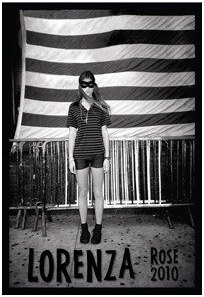
The original Lorenza True Rosé label (2008 through 2011)
2012 Lorenza True Rosé (27% Cinsaut, 25% Mourvèdre, 28% Grenache, 20% Carignan)
A brick-orange color, strikingly similar to the younger wines (2016, 2019, and 2021) tasted alongside this vintage. Not only is the fruit quality in this bottling fresher than in 2010 (lacking the traces of caramelized notes found in 2010), the profile is exceptionally savory, with cherry skin and dried rose petal nuances. On the palate, the wine is delicate in its lightness (just 11.8% alcohol), zesty, fine, and silky, while the fruit qualities take on a lively white pepper-like complexity, with its natural, palate freshening acidity adding to the savory quality.
Melinda Kearny: As the nose unfolds, you get nuances of cantaloupe, peach, and green apples, or is it a golden delicious? —almost a ripe, juicy fruit salad character. On the palate, the wine is not just as fresh as ever, but super-long and fine. The weight of 2012 is reminiscent of 2019 — both vintages came in with such lively acidity. I remember the harvest was during the first week of September, and the grape sugars were lower than usual, similar to 2011 in that respect. To bolster 2012, we gave this wine some extended lees [i.e., spent yeast cells) contact, with some stirring of the lees in the Grenache tank.
2016 Lorenza True Rosé (36% Grenache, 28% Carignan, 28% Mourvèdre, 8% Cinsaut)
A pale brickish-pink color, similar to 2012. But at four years less age, the fruit profile in the nose is even lusher and still opulent, dripping with cantaloupe in the nose, with tingling twists of peppercorn-like spice. At nearly six years old, the youthful aroma of this wine is not just unsuspected, it's shocking. On the palate, it has the Lorenza touch — very light (11.4% alcohol), airy, desert-dry feel, punctuated by vibrant acidity adding up to a delicious, mouth-watering quality.
Melinda Kearney: In 2016 the percentage of the Bechthold Vineyard Cinsaut went down because we increased our production to 3,920 cases. The wine has an unabashed "sun-kissed" quality, is very generous in delivery, and is also overtly spicy. I almost want to have a chili-peppered Asian-style shrimp dish with this, even though I'm terribly allergic to shrimp!
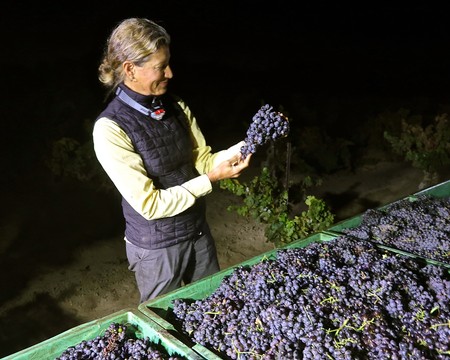
Melinda Kearney harvesting 2021 Bechthold Vineyard Cinsaut during the hours before dawn.
2019 Lorenza True Rosé (34% Grenache, 29% Mourvèdre, 26% Carignan, 11% Cinsaut)
As the vintages tasted got younger, the fruit qualities in the aroma became lusher, but what's surprising is that they also retain both mineral and rose petal nuances, common threads going back to 2010. The 2019's palate profile also continues the thread of being airy in its lightness, and savory and zesty with acidity; the minerality, tartness, and bone dryness seem to only sharpen the red-berryish fruit.
Melinda Kearney: Our 12th vintage, like being gifted with a dozen "rosés." I like the way the high acids balance with the minerality to produce layers of Meyer lemon and raw honey in the mouth, with peach, apricot, jasmine, and guava in the fruit profile.
2019 was an example of a year when we aimed towards 19° [which theoretically converts into approximately 11% alcohol], but grapes came in as low as 16° — particularly, our Mourvèdre from Ripken Vineyards — and some as high as 20°. We ended up with an average Brix of 19°, and the wine finished at a ballerina-like 11% alcohol.
2021 Lorenza True Rosé (30% Mourvèdre, 28% Grenache, 28% Carignan, 14% Cinsaut)
The fruit in this yet-to-be-released wine is effusive with fresh tropical notes, still flowery and irrepressibly intense in its just-picked character. On the palate, the acid balance gives the super-floral, perfumed fruit a mouth-watering quality, and the texture is silken fine and light (just 11.4% alcohol).
Melinda Kearney: Our latest vintage will be released on Valentine's, February 14, 2022. We're "all about the love" here at Lorenza. I'm so pleased with this wine — it may be our best ever. The acid is so vibrant, yet the intensity, the perfume, is probably the strongest of any of our past wines at this stage. There's lots of activity all over the palate. The sensations along the sides of the mouth, I think, are activated by the cranberry-like character that the Carignan contributes, while Grenache brings its own sassy acid and spice, the Mourvèdre the angles and rhubarb and structure, and the Cinsaut the roundness and additional weight.
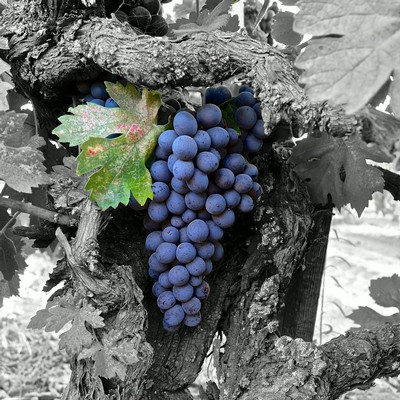
2021 Cinsaut in Bechthold Vineyard's "rosé block".
Lorenza True Rosé and food matches at M Sushi Bistro
Our combined comments on some of the dishes tasted at Lodi's M Sushi Bistro owned and operated by Chef Minh Nguyen and his wife Hong Dinh, who also have a deep affection and affinity for Lodi-grown wines...
Hamachi (yellowtail) nigiri — Pale-colored yellowtail has a more delicate or delineated, less fatty taste than typical raw tuna. We loved the 2012 Lorenza because its aged quality had the delicacy to enhance the taste of hamachi, yet the combination of acidity and moderate alcohol (11.8%) gave the wine enough youthful complexion to brighten the fish-like a squeeze of fresh lemon.
Kampachi (amberjack) nigiri — Kampachi is a richer, fattier, more aggressively flavorful type of tuna that made a seamless match with the lavishly fruited 2019 Lorenza rosé. With the fuller 2012 (fuller because of its more rounded, evolved quality, not because of its alcoholic weight), however, the kampachi brought out even more of the aged complexity in 2012; while 2012 has retained ample enough acidity to freshen the palate between bites of this rich, fatty fish in its pristinely faw form.
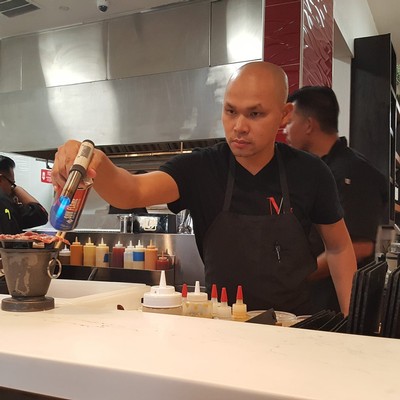
M Sushi Bistro chef/owner Minh Nguyen. Bob Highfill, Stockton Record.
Uni nigiri — Uni, the pale orange, soft and tongue-textured meat of the sea urchin, is admittedly an acquired taste — very earthy with just a faint touch of brininess. It is also extremely high in umami, the high amino acid component in food that is valued for its savory quality (ketchup and Parmigiano cheese, for instance, are different examples of high-umami foods which bring out the flavor of other foods). With the uni, it was the Lorenza rosés with the most delineated minerality, which were the older vintages (2010 and 2012), that made the most seamless match with the earthy taste of the uni.
The best wine of all with the uni, however, was a bottle of 2020 Domaine Tempier Bandol Rosé which Melinda brought along to compare with her own rosés. While Kearney's model for Lorenza is Domaine Tempier, it is virtually impossible for a California-grown wine to duplicate the ultra-minerally, almost briny taste of a Tempier rosé, a wine that makes your palate feel like it's awash with stones mixed with stone fruit. Tempier is Tempier, an essence of Provence, while Lodi-grown rosé is Lodi-grown rosé — the latter, a style of dry pink wine that will always have a sun-kissed fruit quality, even when picked when grapes are young and higher in natural acidity (which tends to accentuate minerality) in the fashion of Lorenza.
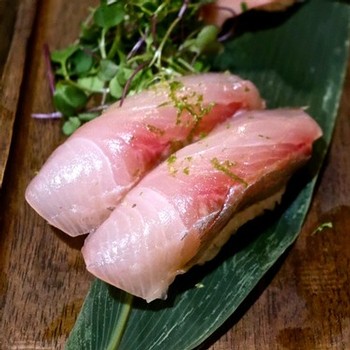
M Sushi Bistro's hamachi nigiri.
M Sushi oysters — Chef Minh has a magic touch with raw oysters, combining the high-umami taste of masago (smelt roe fish eggs) and green onions with the hot spice of wasabi and housemade hot sauce. With this dish, it was the most peppery spice nuanced vintages of Lorenza (2012 and 2016) that balanced out the spice components of this dish. However, it was the younger Lorenza bottlings (particularly 2021) that had the youthful exuberance and flowery fruit quality (which subside after Lorenza rosés hit their fifth or sixth year) that best counteracted the raw heat of the sauce, while the briny taste of oyster itself brought out the minerally character intrinsic in the younger vintage of Lorenza. Again, at the end of the day, it is this "deliberate" style of rosé, picked at low sugars to accentuate acidity (it's higher acid wines that tend to retain the most "mineral" qualities) and to keep the alcohol (11% in 2021) to a very light and easy level, that makes these wines more than compatible with high umami/spice iterations of raw oysters such as this.
Salmon collar with ikura (salmon roe), ponzu, and micro-greens — Another one of M Sushi's delicious combinations of flavor, balancing tart, sweet, bitter, and umami sensations with the fatty/briny taste of salmon and charred edginess of toasted salmon skin. We found that the silky, rounded yet zesty qualities of 2012 seem to "swim" almost effortlessly with this dish (especially in combination with the salmon roe), although 2010 retains just enough acidity to also balance the ponzu's sweet/tart taste and mingle with the umami-rich taste of salmon skin and roe.
Miso soup — When we were served the salmon collar we were also given bowls of M Sushi's silky, earthy miso soup, which is a literal umami "bomb" (miso, as well as tofu, sea vegetables, and green onions, are inundated with this savory sensation). While all the rosés had the lightness and pronounced acidity to "lift" and brighten the taste of miso soup, it was the younger vintages, especially 2021, that seemed to knock this food/wine match out of the park. The youthful, zesty fruit qualities of 2021 were especially invigorating with the garden-green taste of green onions, while the soup brought out the mineral character intrinsic in 2021 and even more discernible in the older rosés. A perfect case of wines and food making each other taste even more vivid and exhilarating.
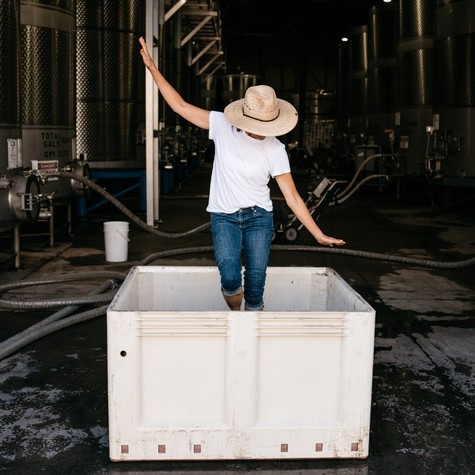
Melinda Kearney foot treading grapes for her Lorenza True Rosé. Photo courtesy of Melinda Kearney.